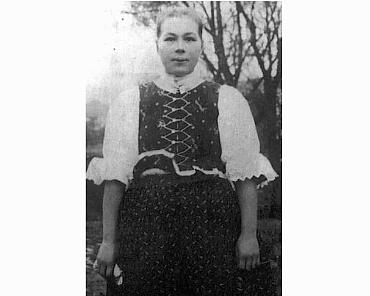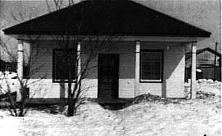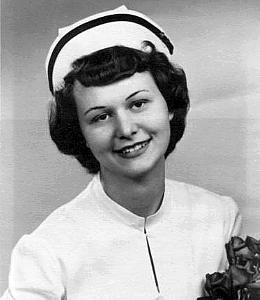Andrew and Terezia Helena Kuhayda : Bradlo 1930-44; Hearst 1944-48.
By Mary (Kuhayda) Schiestel.
Kuhayda, Andrew and Terezia Helena.
Children: Pauline, Mary, Anna, Helen, Elizabeth, Theresa, Andrew, Judith Clara.
Andrej Kuhajda (changed to Andrew Kuhayda sometime after coming to Canada) was born in 1902, in Chlebnice, in the Orava region of Slovakia. Young Andrej attended the local elementary school for the required six years. He was to go for further education at age twelve, but World War I broke out (1914), so plans for higher education were shelved.

Terezia (Tapajna) Kuhayda, marriage day in Chlebnice, Slovakia. Jan 18, 1927.
Terezia Helena Tapajnova was born in 1907, also in Chlebnice, and attended the local elementary school for six years. In 1927, Andrej and Terezia were married in the local Roman Catholic church.
Although the Canadian government considered Czechoslovakians, and many other European nationals, as non-preferred immigrants, agricultural and domestic workers were admitted if a position awaited them, or if they had enough money to look after themselves until jobs were found. By the early 1900s, the CN and CP railways were built from east to west, and now the government needed settlers, especially in the West, to create economic activity to justify the expenditures. In the Railways Agreement of 1925 and 1927, the railways were authorized to invite citizens of these non-preferred countries to come to the Canadian West. So it was that Andrej, after his marriage, left Chlebnice and sailed on March 10, 1927, from Cherbourg, France, to Halifax. He then took the CNR to Winnipeg, where he worked for a time on a farm, before moving to Fort William, where there was a Slovak community. Here he worked as a stevedore unloading ships.
The following is taken from the Manitoba Free Press, February 27, 1923, from a speech given by Sir Clifford Sifton, Minister of the Interior responsible for attracting immigrants.
" A stalwart peasant in a sheep skin coat with a stout wife and half a dozen children makes the best immigrant. In northern Ontario, Manitoba and Saskatchewan, there are enormous quantities of land perfectly fit for settlement. These are not lands on which ordinary Englishmen or Americans will go, but they are fit for peasant settlement. Twenty years ago I settled a number of European peasants on these lands, and those are the only parts where the people are not in debt. They have never left the land, and bankers agree these European peasants have made the most successful settlers. If you are to settle rough lands, you have to settle them with these people, because the average Canadian or American farmer will not do it. "
This, of course, is ironic, because most newcomers, like the Bradlo settlers, would not, and could not, settle for subsistence farming either.
From Fort William, Andrej travelled to Windsor to join that Slovak community. After a time in casual labour he got a job at Seagram's distillery. In late November 1929, Terezia joined her husband, but their stay there was less than a year. They learned of available land being offered in Northern Ontario near Hearst. They arrived in the north in August of 1930 at the worst possible time, when winter was soon to come. Terezia, accustomed to life in a close community in Slovakia, felt isolated. She recalled her dismay about being "dumped into the middle of this bush." On September 11, 1930, their first child, Pauline, was born with Mrs. Ziga, a midwife, in attendance. Pauline was the first child born into the Bradlo colony.
Life was hard, because winters were long and cold. Thirty-two-below Fahrenheit was common. Summers were short and teeming with black flies and mosquitoes. But the land was fertile enough for family needs -- potatoes, carrots, cabbage, and others that stored well. They also had a cow.
Maria Kuhayda (Mary) was born in 1933 and Anna Therezia in 1936. Maria Helena Angela was born in St. Paul's Hospital, Hearst, in 1938. In 1940, Andrej went to work for Ripco Timber (Marathon Pulp & Paper) as foreman of a camp near Mead. He traded in his car for a caterpillar tractor. Much of the timber cut in summer on the company's extensive forest rights was skidded each winter to the Algoma Railway, for transport to the United States. By this time the family was living in their third Bradlo house. Their properties had each in turn already been skimmed of all saleable pulpwood, and the prospect for a living from agriculture, on land that could better be called moose pasture, was dismal. Most of the other Bradlo families were trickling away to better jobs and/or better agriculture in warmer southern Ontario. Andrej stayed because of the good sales of company pulpwood in those war years. He was a forester at heart. Elizabeth Kuhayda was born in 1941, and Maria Theresa in 1943.

Kuhayda house, 1944.
One significant reason for Andrej moving the family into Hearst in the fall of 1944 was that Pauline, the first-born, graduated from Grade 8 at the Bradlo School in June 1944. She started Grade 9 in Hearst that fall, staying with a family before a house was purchased on Prince Street. Now we had electricity and a phone. Andrej enlarged the house to add another bedroom and a bathroom for the soon-to-come water mains/sewers. He also built a basement and enclosed the front verandah to make a porch.

Kuhayda house, 1947.
A garage was enclosed to make a chicken coop and a run behind it; the eggs were appreciated in the war and postwar years. Our mother was a skilled, "old school" gardener, and grew our potato and other vegetable requirements in our backyard.
Mary, Annie and Helen continued at the Bradlo School for a few weeks in the fall of 1944, and resumed Grades 7, 3 and 1, respectively, with the move to Hearst. The separate school taught only in French, so they attended the HPS. That building was quite new, a large solid and square structure with four classrooms on two levels. The basement was an auditorium/play area, with toilets. The Kuhayda children to that point were learning English upon starting school; the challenge of coping in three languages might have been excessive. The town was more than half French-speaking, so it was inevitable that some of this language was eventually picked up, too.
Pauline got a summer and weekend job at Smith's ice cream and candy store (although ice cream was rarely available until after the war). Mary began by babysitting for the Tom Flood family, and for Dr. Antonik. Later, Annie babysat the grandkids of Mayor McNee. The one Kuhayda son, Andrew, was born in November 1945.
In those years, the town of Hearst was selling four-acre lots along the Mattawishkwia River, and Andrej purchased one. It was located where a large rock extended almost across the river and could be seen at low water in summer. The lot was cleared of trees and brush one summer with the bulldozer, and used at least two summers for extra potato crops. When the family left Hearst, this lot was sold. Today, the southern part is included in A.L. Kinsey Park, and the northern part of the lot is residential.
Andrej quit the pulpwood business in 1948 and worked that summer as a foreman of a construction company, digging trenches in the streets of Hearst for water and sewer mains. The holes were large and deep in order to be below the frost line.

Pauline Kuhayda graduating as RN in 1953.
Judith Clara, the last of the family, was born in 1948. In early fall of 1948, Andrej went to southern Ontario to scout for farms. He found a hundred-acre farm on Highway 76 south of West Lorne. Previous Bradloites, Andrew Janoska and Steve Wydareny, already had farms in that general area. There were two major reasons for the family to leave Hearst. One was that the pulpwood business was falling off, due to the war ending and the government's new policy of wanting the pulp to be turned into paper in Canada rather than exporting it raw to the U.S.A. Hearst suffered some recession thereafter, until the resources in the area became better used. The second reason was that Pauline had graduated from Grade 12 and had started nursing school in Timmins. Andrej decided that the prospects for further schooling or training for the Kuhayda children meant going south, and the means for livelihood meant a better farm had to be bought.
Can you provide corrections or comments?
Please report technical issues to: